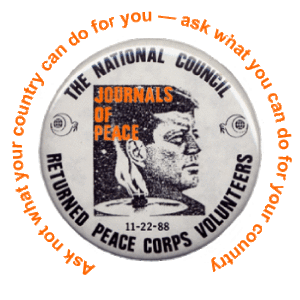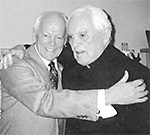RPCVs Pay Tribute
To
President Kennedy
And His
Peace Corps Legacy
World
View Magazine: "RPCVs Pay Tribute to President Kennedy
and His Peace Corps Legacy" by Katy Hansen
Tina Martin poured out her heart into 28
journals and diaries during her years in Peace Corps. Wherever she ventured in Tonga, she carried a
note-book and pencil in her basket.
"I've never before shared a word of my
diary with anyone," she says.
But now she has. Martin retrieved her treasured journals and
briefly shared their private contents with the world. Martin was among some 400 returned Peace
Corps volunteers who gathering in the U.S. Capitol Rotunda November 21-22 to read
from their Peace Corps diaries, journals and letters home. They gave personal testimony to the indelible
moments that crystallize their Peace Corps experience years afterwards.
The occasion was "Journals of
Peace"--a 24-hour vigil of readings organized by the National Council o
Returned Peace Corps Volunteers. The
unique event was former volunteers' special way of commemorating the legacy of
President John F. Kennedy on the 2tth anniversary of his assassination.
Not all journal readings dealt with Kennedy.
The Journals of Peace vigil also became a gift from ex-volunteers to the 94
countries they have served, as well as a gift transmitted during Thanksgiving
week to the American public via extensive national media coverage. A memorial service in St. Matthew's
Cathedral, attended by 1,500 persons in Washington, D.C., capped the tribute.
"When I heard about Journals of Peace, I
instantly wanted to do it," said Warren Kinsman (RPCV, Turkey). "I just felt so strongly that Peace
Corps was Kennedy's greatest achievement."
Elizabeth Swanson (RPCV, Sierra Leone)
travelled al the way from Mission Viejo, Calif. with two daughters "to
relived Kennedy's idealism and revive it."
Reading their personal journals in the hallowed
Rotunda and listening to the readings of other returned volunteers was unforgettable
for many. "It was very very moving
to be in this Rotunda," said Sarah Wilkinson McMeans (RPCV
Philippines). "The letter I read
was very personal. I could feel the
people listening and become quiet as I spoke."
"It's amazing so many of our experiences
and feeling were the same. Even the
words we all use are the same," noticed Phyllis McClure (RPCV, Nigeria).
Not everyone expressed themselves in words
alone. Adryan Russ (RPCV, Colombia) came
from her home in Sana Barbara, Calif. to sing a song she composed about her
Peace Corps experience titled, "We're Not That Different, You And
Me." Ann and Mike Moore (RPCVs, Togo)
journeyed from Evergreen, Coo. to render a Kenyan tune, "O Sikilia."
Former Peace Corps volunteers unable to attend
Journals of Peace submitted their journal excerpts to be read by surrogates
during the after-midnight hours of the non-stop vigil, which concluded at noon
Nov. 22.
A memorial Mass at St. Matthew's Cathedral,
site of President Kennedy's funeral 25 years earlier, drew a standing room only
congregation to conclude the Journals of Peace.
Led by fags from countries around the world, dignitaries including
Sargent Shriver, Loret Ruppe, Bill Moyers, Rev. Theodore Hesburgh, former Sen.
Paul Tsongas (RPCV, Ethiopia) and other members of the extensive Peace Corps
family filed into the church.
"I think if Kennedy were standing here
today," Hesburgh told the assemblage,"...he would say 'You are the
people who took the best message that I gave to the world. It is...Peace Corps people who will be my
best and proudest legacy.'"
Moyers, first deputy director of the Peace
Corps and now a noted journalist, brought the commemoration to a close. "Something survived those years which
bullets could not stop. An idea survived,
embodied by the Peace Corps volunteers who are now 1125,00 strong and still
coming," he said. "Out there
in the world, as John F. Kennedy might say, is truly the new frontier."
Journals of Peace and is concluding church
service attracted significant public interest.
One non-RPCV, James Coughlin, made his way from Cambridge, Mass. to
observe every minute of the 24-hour vigil in the Rotunda. His aunt had been Kennedy's personal
secretary, and Nov. 22 was Coughlin's birthday.
"I turned 10 on the day of the
assassination," Coughlin explained as he listened to the readings of
former Peace Corps volunteers. "For
25 years I've had trouble being happy on my birthday. But it's like a huge extended family in this
Rotunda today. I've been waiting 25
years to come to an event like this, to cry tears not only of sadness but of
joy."
At long last, Journals of Peace gave him a
happier birthday.





